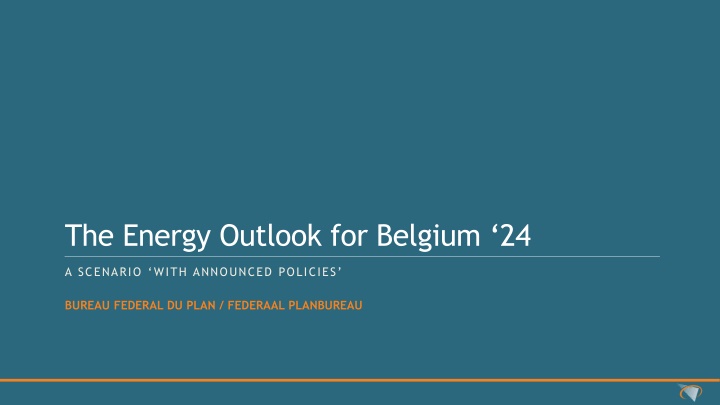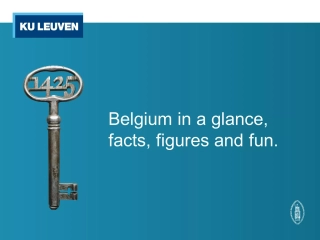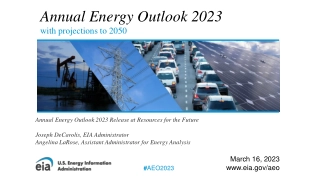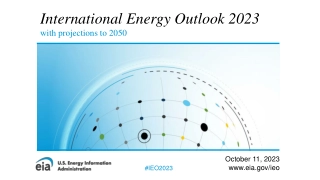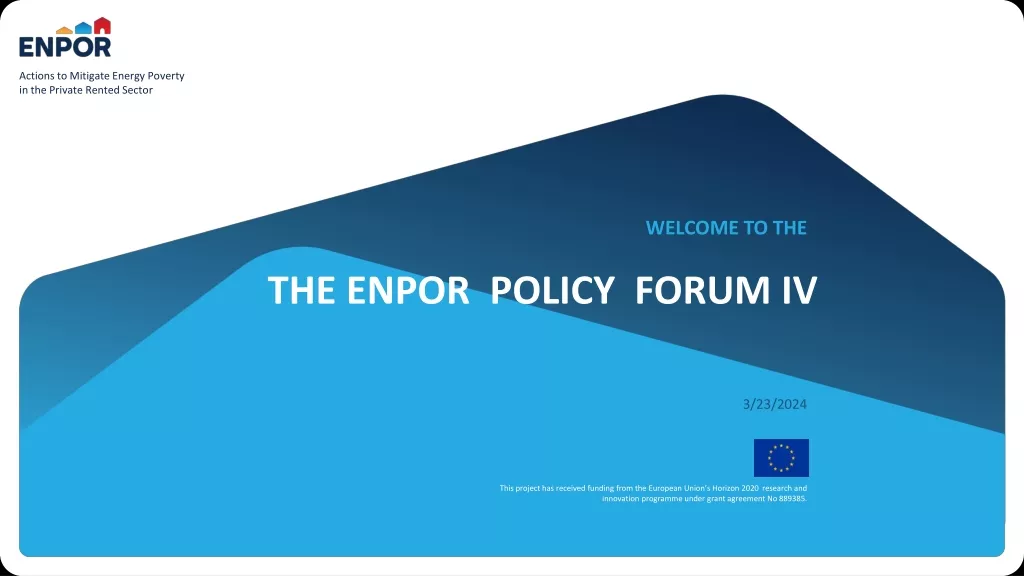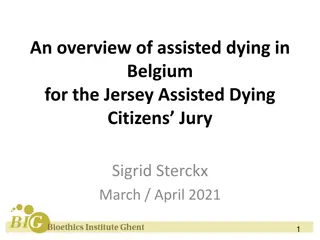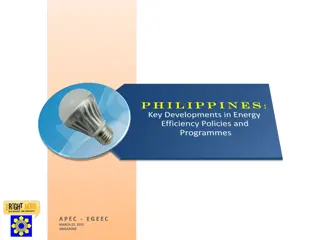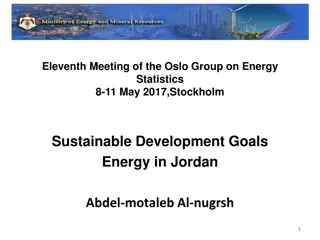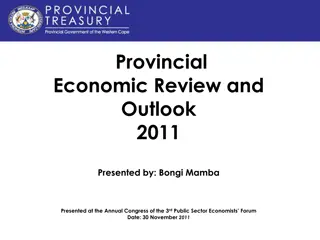Energy Outlook for Belgium: Announced Policies Scenario
The Energy Outlook for Belgium provides insights into future energy trends in the country based on announced policies. This report from the Federal Planning Bureau offers a comprehensive analysis of the energy landscape, including projections and potential implications. Dive into the anticipated energy scenario and policy considerations to understand the trajectory of Belgium's energy sector.
Download Presentation

Please find below an Image/Link to download the presentation.
The content on the website is provided AS IS for your information and personal use only. It may not be sold, licensed, or shared on other websites without obtaining consent from the author.If you encounter any issues during the download, it is possible that the publisher has removed the file from their server.
You are allowed to download the files provided on this website for personal or commercial use, subject to the condition that they are used lawfully. All files are the property of their respective owners.
The content on the website is provided AS IS for your information and personal use only. It may not be sold, licensed, or shared on other websites without obtaining consent from the author.
E N D
Presentation Transcript
The Energy Outlook for Belgium 24 A SCENARIO WITH ANNOUNCED POLICIES BUREAU FEDERAL DU PLAN / FEDERAAL PLANBUREAU
Energy Outlook for BE 2024 Previously, a WEM (With Existing Measures) philosophy Usually taken to name scenario of inaction WEM usually has a WAM accompany it Usually a scenario with theoretical policies to reach a target Our scenario can be understood as intermediate Announced Plegdes, made in the Fit-for-55 framework But only policies, no targets With a certain grey zone prudent when unsure Can be quantified in PRIMES model Between 2030 2050: Significant political uncertainty 2
A methodological intermezzo PRIMES - A techno-economic model Agents decide to consume to satisfy their given energy demands, given costs and government policies (exogenous parameters) Yielding final consumption, supply and emissions Not necessary an optimal outcome Except for the power sector Social planner decides investment, unit commitment, pricing that ensures system viability 3
The results: decarbonisation 140 CO2-emissions (Mtonne) GHG emissions (Mtonne) 160 120 Industry (Process-) 140 100 120 Transport 80 100 Service and agri. 80 60 Residential 60 Industry (Combustion) 40 40 Energy sector 20 20 Electricity and heat 0 0 2005 2010 2015 2020 2025 2030 2035 2040 2045 2050 2005 2010 2015 2020 2025 2030 2035 2040 2045 2050 Electricity and heat Residential Industry (process) Energy sector Tertiary Industry (combustion) Transport Total GHG emissions Of which ETS-1 sector Of which ESR sector ESR objective 4
The results: supply (power) generation Steady increase in wind and solar Electricity production (TWh) 140 Gas remains a player 120 ETS-1 is only major policy lever after 2030 100 Electricity consumption unprecedented, after 2030 80 60 By 2050 non-neglible part for production of synthetic fuels 40 20 0 2005 2010 2015 2020 2025 2030 2035 2040 2045 2050 Nuclear energy Biomass and waste Hydro Wind Photovoltaics Geothermic Solid fossil fuels Petroleum products Natural and fabricated gas 5
Research avenues Study Commission Public Investments Based on DG Environment analysis of possible scenarios Focuses on the public investments share of needed Capex CERAC Cost of non action and adaptation Sequence: Physical risk identification => adaptation mesure alternatives => cost Public finance approaches considered in parallel Federal Planning Bureau Optimisation model (PRIMES, TIMES) General equilibrium model for impact on industry, labour market, etc. Microsimulation for impact on household by income level 6
The Energy Outlook for Belgium 24 A SCENARIO WITH ANNOUNCED POLICIES BUREAU FEDERAL DU PLAN / FEDERAAL PLANBUREAU
The results : residential energy consumption Final energy consumption residential 12 10 Policies impactful before 2030 Heat networks Electricity 8 Solar boilers Mtoe More efficient -> impact rules, new technologies 6 Biomass Natural gas 4 Petroleum producgts Petrol (and solids) are on the way out 2 Solid fuels 0 2005 2010 2015 2020 2025 2030 2035 2040 2045 2050 Gas holds its own 5 Buildings by energy technology (millions) 4.5 Heat pumps break through but then falter 4 3.5 3 Distributed heat bumps into limits 2.5 2 1.5 1 0.5 0 2020 2025 2030 2035 2040 2045 2050 Conventional technologies Heat networks Heat pumps Renewable energy equipment 8
The results : service and agriculture energy consumption 7 Policies most impactful before 2030 6 Same dynamics as for residential apply 5 But agents are more susceptible to plan ahead Quicker reactivity to policies In fact, too quick (base year 2020!) 4 3 Growth of tertiary sector ensures energy consumption rise later on 2 1 0 2005 2010 2015 2020 2025 2030 2035 2040 2045 2050 Solid fuels Biomass Electricity Petroleum producgts Solar boilers Heat networks Natural gas Geothermical energy 9
The results : transport energy consumption 12 Complicated since it mixes passenger & freight Final energy consumption transport (Mtoe) 10 In passenger: progressive electrification 8 European rules Facilitated by regional policy (charging points) Speeds up after 2030 6 4 Freight 2 Diesel remains in freight But biofuels progress, too (REDII) 0 2005 2010 2015 2020 2025 2030 2035 2040 2045 2050 LPG Natural gas Gasoline Electricity Diesel Biofuels Kerosone Hydrogen Residual fuels 10
The results : industry energy consumption 12 Even more complicated since different sector = different technologies 10 ETS-1 causes a pre-2035 switch towards electricity 8 Driven by chemicals & steel 6 Stagnation due to feeble rise of ETS price afterwards 4 2 After 2035 hydrogen is coming 0 2005 2010 2015 2020 2025 2030 2035 2040 2045 2050 Driven by chemicals Solid fuels Electricity Petroleum products Heat Natural gas Other sources 11
The Energy Outlook for Belgium 24 A SCENARIO WITH ANNOUNCED POLICIES BUREAU FEDERAL DU PLAN / FEDERAAL PLANBUREAU
The hypotheses: socio economic Demographics Euro per boe 70 Own projection of january 2023 Household size declines 60 Macro-economic 50 Study Commission on Ageing And GEM-E3 for sectoral distribution More services, less manufacturing Less heavy, more light manufacturing 40 30 20 International prices 10 WEO AP 2022 A world decarbonising but not entirely 0 2025 2030 2035 2040 2045 2050 Crude oil Natural gas Coal 13
The hypotheses: techno economic Relative cost of technologies Price of a heat pump (euro per kwh) 1800 PRIMES data based on engineering data 1600 Freely consultable Heat pump and hydrogen tech as examples 1400 1200 Exogenous! 1000 No induced endogenous technical change 800 600 But policies are rather strict 400 200 0 2020 2030 2050 Heat pump air Heat pump water Heat pump ground Heat pump gas 14
The Hypotheses: policies 1 EU Framework Major policies, no targets ETS 1: WEO AP 2022 trajectory (!!!) Phase-out allowances + CBAM ETS 2: 45 euro per tonne Standards for vans and cars Noteably: the thermic ban from 2035 onwards ETD: minimum excise rates Norms new buildings And some norms on biofuels + RNFBOs 15
The Hypotheses: policies 2 Federal VAT excise duty measures Regulations on biofuels Capacity measures (offhore & floating) Regional EPB regulations Fuel switching measures (subsidies & rules) Infrastructure EV charging (implicit) Zoning (implicit) small fry Buses, trains LEZ and km charge HDV 16
The Hypotheses: policies 3 What NOT? Company car reform Corporate income, registration tax Rules on public sector governmentleads by example Except for rail and bus companies Specific building rules Rules at transfer of property Rules at acquisition Rules for rented buidlings . Also : Gas in Wallonia & Thermic ban in Flanders (!) Two variants coming: ETS-1 & -2 carbon price & transport rules 17
The results : residential energy expenditure 6000 Energy expenditure per households (euro2022) Fuel as well as equipment cost as a whole rise 5000 Gas price hike & investment bump 4000 Fuel (electricity included) lessen afterwards 3000 Investment expenditure remains historically elevated 2000 Part of capital rises 1000 0 2005 2010 2015 2020 2025 2030 2035 2040 2045 2050 Capital cost Fuel costs 18
The results : tertiary energy expenditure Unit cost of production, tertiary (index 100 = 2000) 300 Sharp spike in equipment costs 250 200 But relatively low rise in overal costs of energy 150 100 And overall costs decline structurally after 2030 50 0 2000 2005 2010 2015 2020 2025 2030 2035 2040 2045 2050 Energy related unit cost of production of which related to energy equipment (capital and O&M) of which related to fuel purchases 19
The results : transport energy expenditure Structure of passenger transport costs 100% Flatlining overall costs 90% 80% 70% Slowish decrease in fuel cost 60% 50% 40% But, again, a larger share of equipment costs 30% 20% 10% 0% 2005 2010 2015 2020 2025 2030 2035 2040 2045 2050 Fuel cost Capital cost Other costs 20
The results : industry energy expenditure 450 Contrary to tertiary, sharply rising overall unit costs of energy Unit cost of production, energy related cost (index) 400 350 300 Only for some do these abate 250 200 At given level of technology, chemicals, metals and non-metal materials have a problem 150 100 50 0 2020 2030 2050 Iron and steel Chemistry Paper and pulp Machine building Non-ferrous metals Non metallic minerals Food, drinks and tobacco Textile 21
The results : industry energy expenditure Energy cost hikes in relation to industry value added 350 300 Unit costs or energy index in 2030 (2020 = 100) Energy costs are concentrated in relatively small industries 250 200 Except for chemicals 150 100 0 5000 10000 15000 20000 25000 Value added (millions of Euro2019) 22
The results: electricity costs 180 Transmission and capital costs increase Structure of electricity costs (euro2022) 160 140 ETS price payments displace fuel costs 120 100 80 Murky contribution of other costs 60 40 Rising cost (price) of electricity 20 0 2020 2030 2040 2050 Annual capital costs Fixed operating costs Variable operating costs Fuel costs Taxes and subsidies Transmission and others 23
